Tom's Journal - The Alaska Highway Part 2, Days 14 - 20
We Made IT!!!
We made it to the official end of the Alaska Highway!
The Alaska Highway, Part 2
The local news had rumors of a wildlife animals strike starting Sunday, June 21. It seems that the animals are not happy with the economic conditions and the impact it is having on them. They are concerned with their current contract and the number of days and hours that they are required to make appearances along the road side and the number of sightings, foraging, and posing they are required to make. All the large animals voted for and are supporting the strike. However, The smaller rodents and birds feel like it would be an undue hardship and are maintaining their normal routine; besides, they quite enjoy their acting careers and entertaining travelers.
Day 14 (Sunday, June 21)
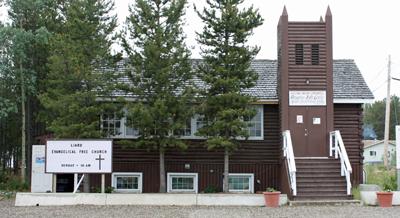 Watson Lake: we attended an
Evangelical Free Church with about 15-20 people.
We drove by the night before and clearly saw that the service
started at 10:00 AM. But
somehow on Saturday night and Sunday morning I had it in my mind that it
started at 10:30 so we arrived mid service.
Good service and great people.
We stayed afterwards and talked for about 30 minutes as we were
invited for their Father's Day lunch but we thanked then for the
hospitality but didn't stay.
We probably should have stayed as we were having good conversations and
insights of the area.
Watson Lake: we attended an
Evangelical Free Church with about 15-20 people.
We drove by the night before and clearly saw that the service
started at 10:00 AM. But
somehow on Saturday night and Sunday morning I had it in my mind that it
started at 10:30 so we arrived mid service.
Good service and great people.
We stayed afterwards and talked for about 30 minutes as we were
invited for their Father's Day lunch but we thanked then for the
hospitality but didn't stay.
We probably should have stayed as we were having good conversations and
insights of the area.
In the afternoon, we went back to the Sign Post Forest for more pictures and then drove out to the Watson Lake Airport Terminal, built in 1942, but it was closed, oh well. It was used for plane transports to the Pacific and Russia during WWII and supplies for the building of the Alaska Highway.
Day 15 (Monday, June 22)
Off again! Great scenic views and vistas as we drove to Teslin but no wildlife as we get our first taste of the impact of the strike.
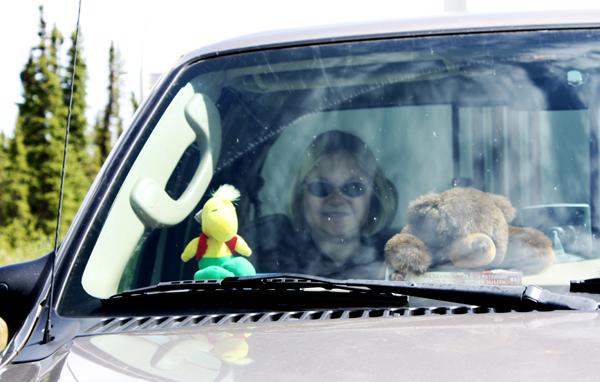
Becky waiting for Tom in the truck with Woodstock and Fahren
162 miles from Watson Lake to Teslin; Alaska Highway mile 761 of 1471 to Fairbanks.
We stopped by the Yukon wildlife display next to the RV park to see a good display of stuffed wildlife since the live ones would not come out and play.
We had a great visit at the George Johnston Museum. George Johnston was a Teslin Tlingit in what I would term the transition period for the Tlingit. There was a very informative 50 minute film on George. George bought a mail order camera as a teenager/young man and his pictures for the next 40 years did a great job of chronicling life at the time (circa 1910 - 1950). The Teslin Tlingit where trappers and traders for the most part. George bought a car in Whitehorse and had brought it down the river as cargo on a paddle steamer to Teslin. It was the first car in Teslin and he built a four mile road to drive it on and drove it out on the frozen lake during the winter for hunting and checking his trap lines. He ran a taxi service and charged people one dollar to take a ride. George's three mile road was used as part of the Alaska Highway.
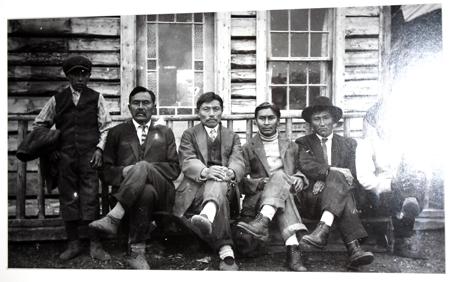
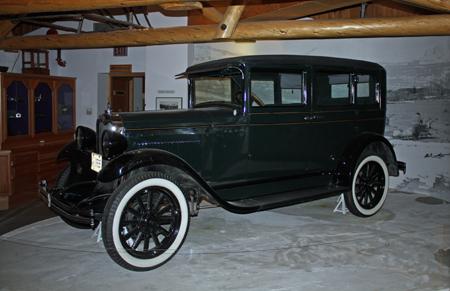
Picture taken by George Johnston of fellow Tlingits George Johnston's car after restoration
Day 16 (Tuesday, June 23)
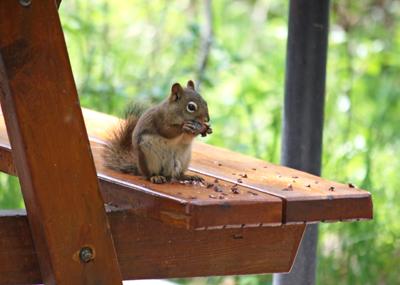
Hey! What's for lunch?
In the morning on our way out of town, we stopped at the Teslin Tlingit Heritage Centre. It is an important centre for the Tlingit to preserve their culture but not of great interest to us.
Teslin to Whitehorse: more great scenery. The only wildlife was a great looking Red Fox that ran by us on the side of the road. We couldn't stop to get his pictures as it appeared that he was late to a wildlife union meeting.
111 miles from Teslin to Whitehorse; Alaska Highway mile 872 of 1471 to Fairbanks.
Day 17 (Wednesday, June 24)
Work day: cleaning, laundry, shopping, and repairs.
Whitehorse is the capital and by far the largest city in the Yukon Territory with about 25,000 residents. The Yukon Territory has about 40,000 total. It is a great city with its own Wal-Mart! There were lots of people bicycling about town, many commute on bicycle. There were joggers along the riverfront. Whitehorse was (and is) a key trading hub. In 1900, the Skagway (on the cost in Alaska) to Whitehorse railroad was built just as the Gold Rush of 1898 was ending. However, mining by big companies continued not only for Gold but Silver an other metals. Whitehorse is on the Yukon River and was the major transport to Dawson City and many Paddle Steamers were used to haul supplies up and ore back along with passengers. During the winter, dog and horse sleds were used for supplies and mail.
Date Night: after a day of cleaning and shopping, we took a wrong turn someplace and ended up at a Boston Pizza for dinner. After dinner, we went to the theatre; the Frantic Follies. It is a great 90 minute vaudeville show that is quite famous. There are numerous tour buses that bring visitors 100 miles from cruise ships at Skagway for the shows. There were only three tour buses full of people tonight but there can be up to eight.
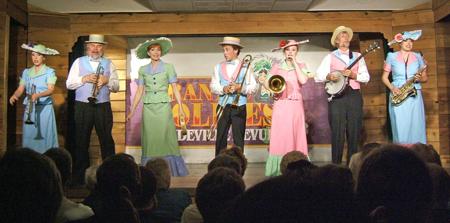
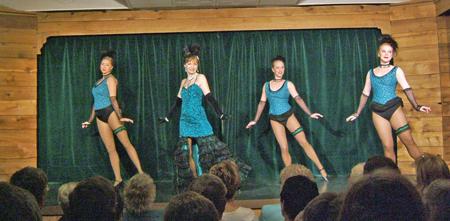
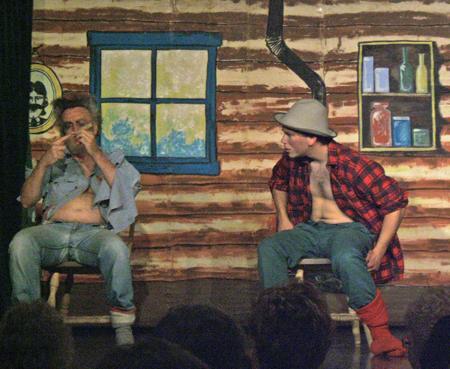
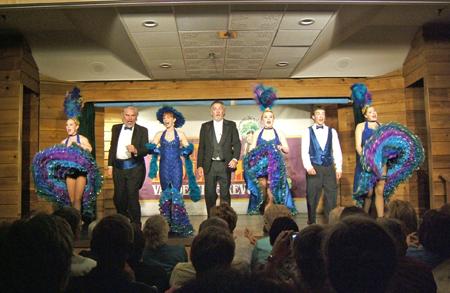
Day 18 (Thursday, June 25)
Spent another day in Whitehorse seeing the sights.
We went by the SS Klondike National Historic Site and learned all about the steam ships that used to be the transportation hub. There was a great 20 minute introductory film and we learned all about powering those beasts by cords of wood. Several igneous methods were used to conserve energy (wood consumption) and there were log stations every 20-30 miles where they could fill up.
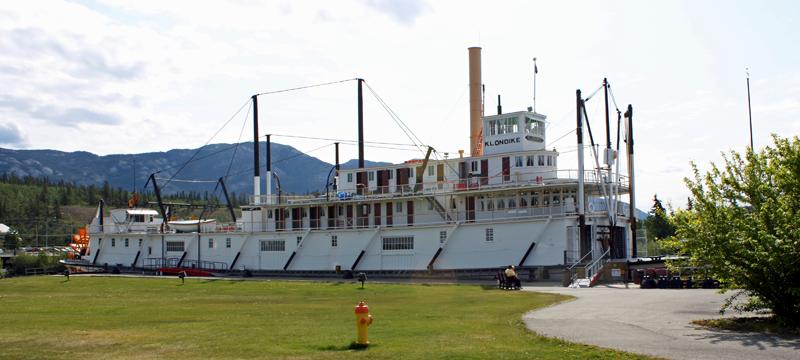
We also went by the MacBride Museum and Old Log Church Museum, built in 1900.
Day 19 (Friday, June 26)
After three nights in Whitehorse to recoup and stock up, we headed back out on the Highway. Once again, great scenery but no wildlife. The strike is now beginning to annoy us. We drove to Destruction Bay on the Kluane Lake. It was one of the staging areas for the building of the Highway and got its name because of a big storm that destroyed the supplies at the staging area.
162 miles from Whitehorse to Destruction Bay; Alaska Highway mile 1034 of 1471 to Fairbanks. Now we're cooking!
Day 20 (Saturday, June 27)
We left Destruction Bay at 8:00 AM as we heard from other travelers heading south that the road was turning rough. Yes, it did turn rough with a lot of patches, frost heaves, and long sections of gravel road repair. The road is a two lane paved highway and the rough spots are not constant but they do require you to slow down as they come up unexpected. There are long stretches of (6-10 miles) of gravel roads (being resurfaced) that is packed hard and actually easier to drive on as you can drive about 40 mph without a lot of bouncing around.
The road in this part of the Yukon was extremely challenging for the original road construction crews and even for road maintenance today because of permafrost. Permafrost is where the ground is frozen several inches under the surface and doesn't defrost during the year. When the road crews graded away the top soil to lay the road, the permafrost melted and turn to slush. The same problem occurs when asphalt is laid on top of permafrost. The asphalt conducts the warmth to the permafrost and causes it to melt which causes frost heaves and road damage. There were a couple of sections where they are experimenting with steel piping and other ways to keep the permafrost frozen below the road.
Overall, the Alaska Highway road is in good shape and easy (and enjoyable) to travel. The curves and climbs are gentle, not like the sharp windy roads of the Sierras. We saw numerous groups of motorcycles riding the highway and I was amazed as we saw several groups (of about 4) and individual bicyclists riding the highway. Most of them had a support vehicle along but three or four of them where heavily loaded down and looked like they were on their own.
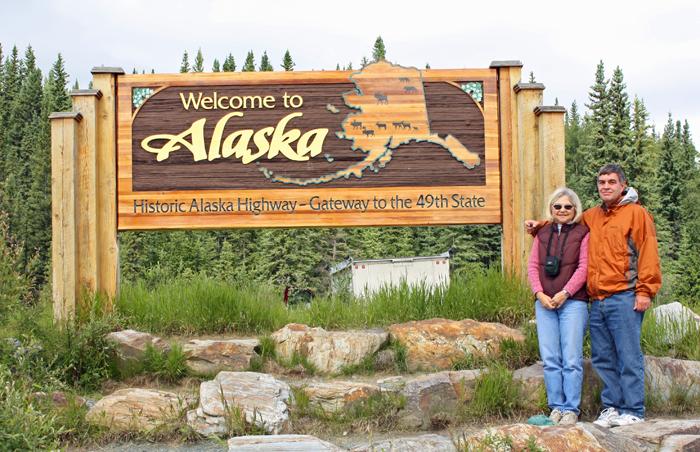
We road the rough road from Destruction Bay to the Alaska border and celebrated our arrival in Alaska. We waited about 7 minutes at the customs and immigration crossing and were greeted by a very friendly agent. He asked how our trip was going so far and recommended some places to see in Alaska and warned of some narrow windy roads as we leave Anchorage.
The road improved a little but still had some rough spots as we drove to Tok. There were great views of the valleys and the many lakes and streams along our way. We were planning to spend the night at Tok (we are passing by Tok again on our way home) but decided it was still early enough and that we would drive on through to Delta Junction, the official end of the Alaska Highway and spend two days in Delta Junction.
336 miles from Destruction Bay to Delta Junction. We left Destruction Bay at 8:00 AM, gained an hour crossing into Alaska, and arrived at our RV park at 4:30 PM. 92 miles left to go to Fairbanks.

Our scenic view while driving

View of an Alaska valley as we enter Alaska